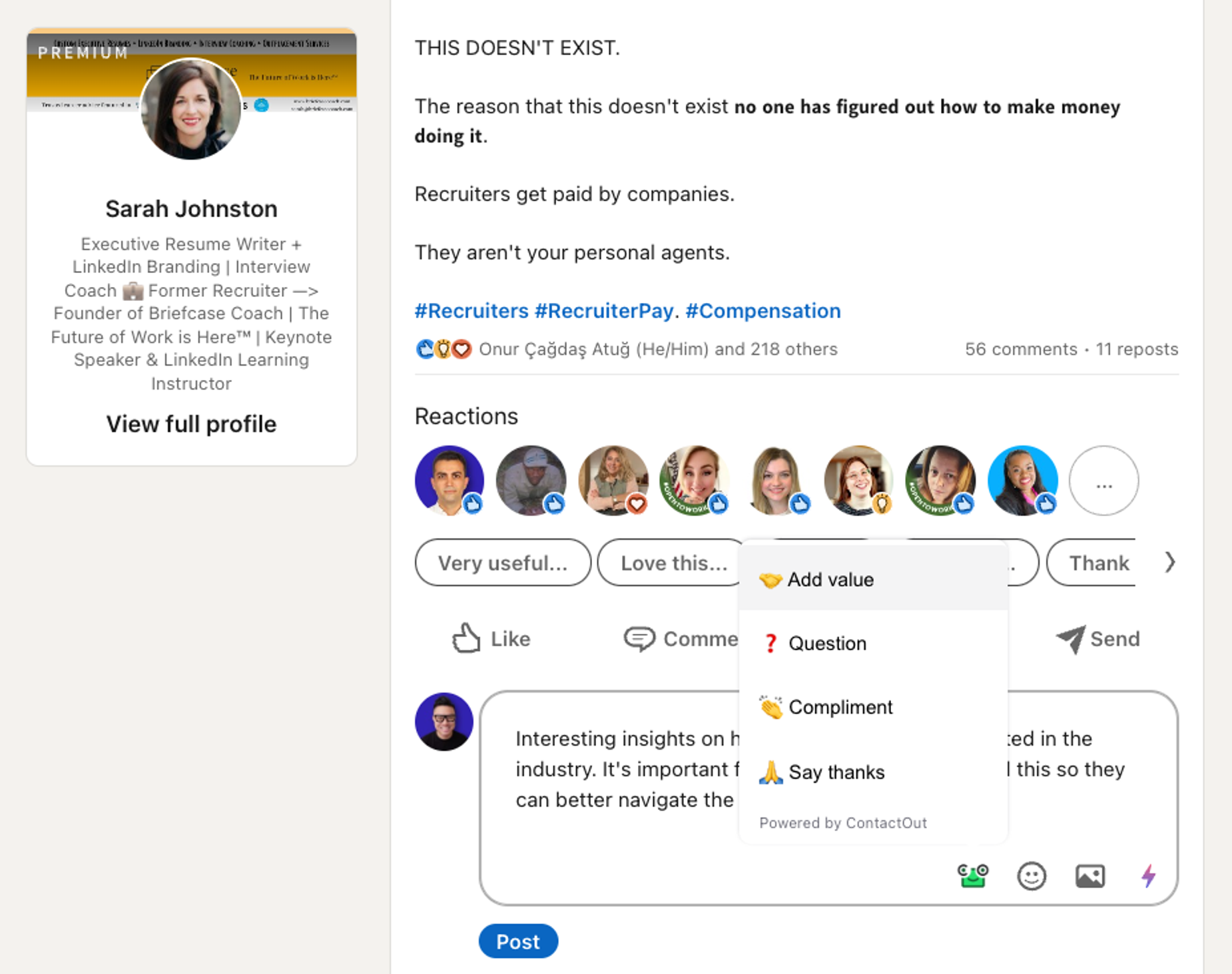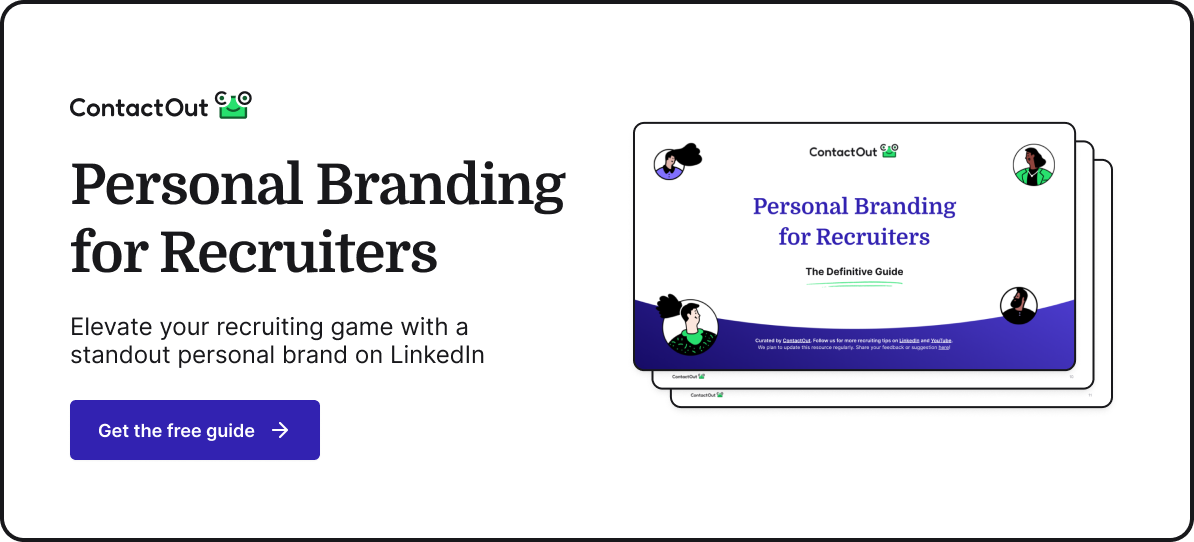This is a comprehensive guide designed to help recruiters build a strong personal brand, particularly on LinkedIn.
It’s not just about setting up a profile; it’s about strategically leveraging the platform to attract the right candidates and clients.
🎓 What will you learn by the end of this guide?
- How to optimize your LinkedIn profile for maximum visibility and engagement.
- Strategies for creating compelling content that resonates with your target audience.
- Techniques for driving organic traffic to your LinkedIn profile.
- How to measure the ROI of your LinkedIn activities.
🚀 Why is it important?
Stand Out in a Crowded Market 🌟
- Why: The recruiting industry is saturated. Without a strong personal brand, you risk blending in with countless others who offer similar services.
- How: Personal branding allows you to showcase what makes you unique—be it your expertise in a particular industry, your approach to candidate relationships, or your success rate in placing candidates.
- Example: If you specialize in tech recruiting, your brand could focus on your deep understanding of the tech industry, your network within it, and your ability to match candidates with companies where they’ll thrive.
Become a Thought Leader 🎓
- Why: Being a thought leader elevates your status from a mere service provider to an industry expert.
- How: Share valuable content, engage in meaningful discussions, and offer insights that aren’t readily available. This positions you as someone who adds value beyond just filling job vacancies.
- Example: Regularly publishing articles on LinkedIn about trends in tech recruiting, such as the rise of remote work or the importance of diversity in tech, can establish you as a thought leader.
Attract Better Opportunities 🎣
- Why: A strong personal brand acts like a magnet for better job placements and more lucrative clients.
- How: When you’re seen as an expert or thought leader, clients and candidates are more likely to trust you with their needs, leading to better job matches and, consequently, a more robust professional network.
- Example: If you’re known for your expertise in tech recruiting, a tech startup looking for a key executive role might reach out to you over another recruiter with a less defined brand.
Expand Your Network 🌐
- Why: A strong brand doesn’t just help you in the short term; it’s an investment in your future.
- How: As your brand grows, so does your network. A larger network means more opportunities for placements, partnerships, and career growth.
- Example: By consistently sharing valuable insights, you attract a broader audience. This could include industry professionals, hiring managers, and even other recruiters, expanding your reach and potential for various opportunities.

Source: Sundin
👋 Personal branding is not just a buzzword; it’s a career strategy. It helps you stand out, adds credibility, and attracts better opportunities, making it indispensable in today’s competitive job market.
Here’s the step by step to do it: 🛠️
1. Profile Optimization 🖼️
- Photo:
Why: First impressions matter. A professional headshot adds credibility.

Source: Sundin
How: Choose a clear, high-resolution image where you’re dressed professionally.
Pro Tip: Use a neutral background to make you the focal point.
- Headline:
Why: This is the first thing people read after your name. It should encapsulate your role and value.
How: Use keywords related to your industry and role. Make it catchy but professional.
Example: “Connecting Top Talent in Tech with Innovative Companies.”

Image source: Sarah Johnston - Summary
Why: This is your elevator pitch. It should give people a reason to connect with you.
How: Start with a hook, explain what you do, and end with a call-to-action (CTA).
Example: “Passionate about bridging the gap between talent and opportunity in the tech world. Let’s connect!”
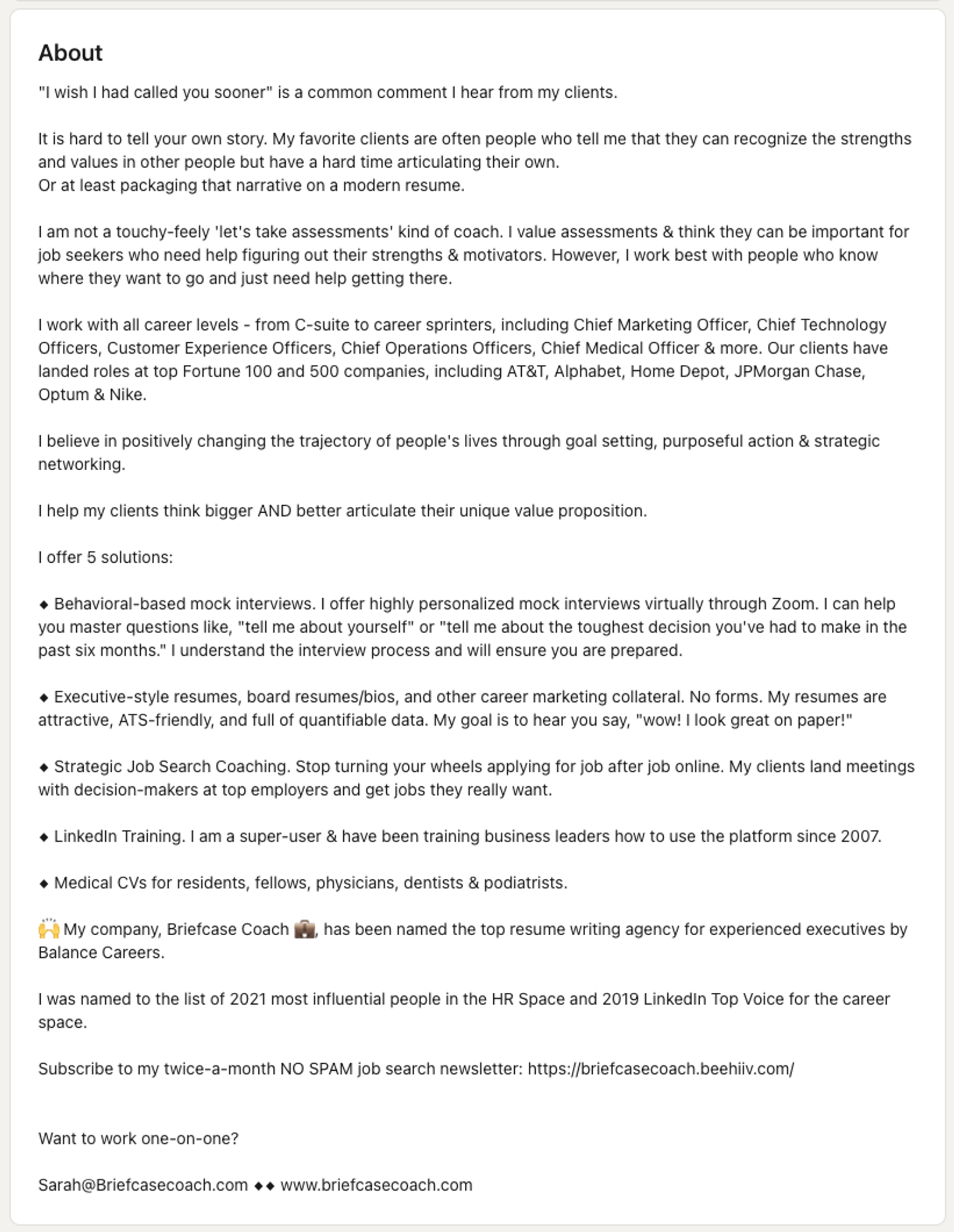
Image source: Sarah Johnston - Skills & Endorsements:
Why: These add credibility and help you show up in search results.
How: Add skills that are relevant to your job and industry. Seek endorsements from colleagues, candidates, and clients.
Pro Tip: Endorse others; they’re likely to return the favor.
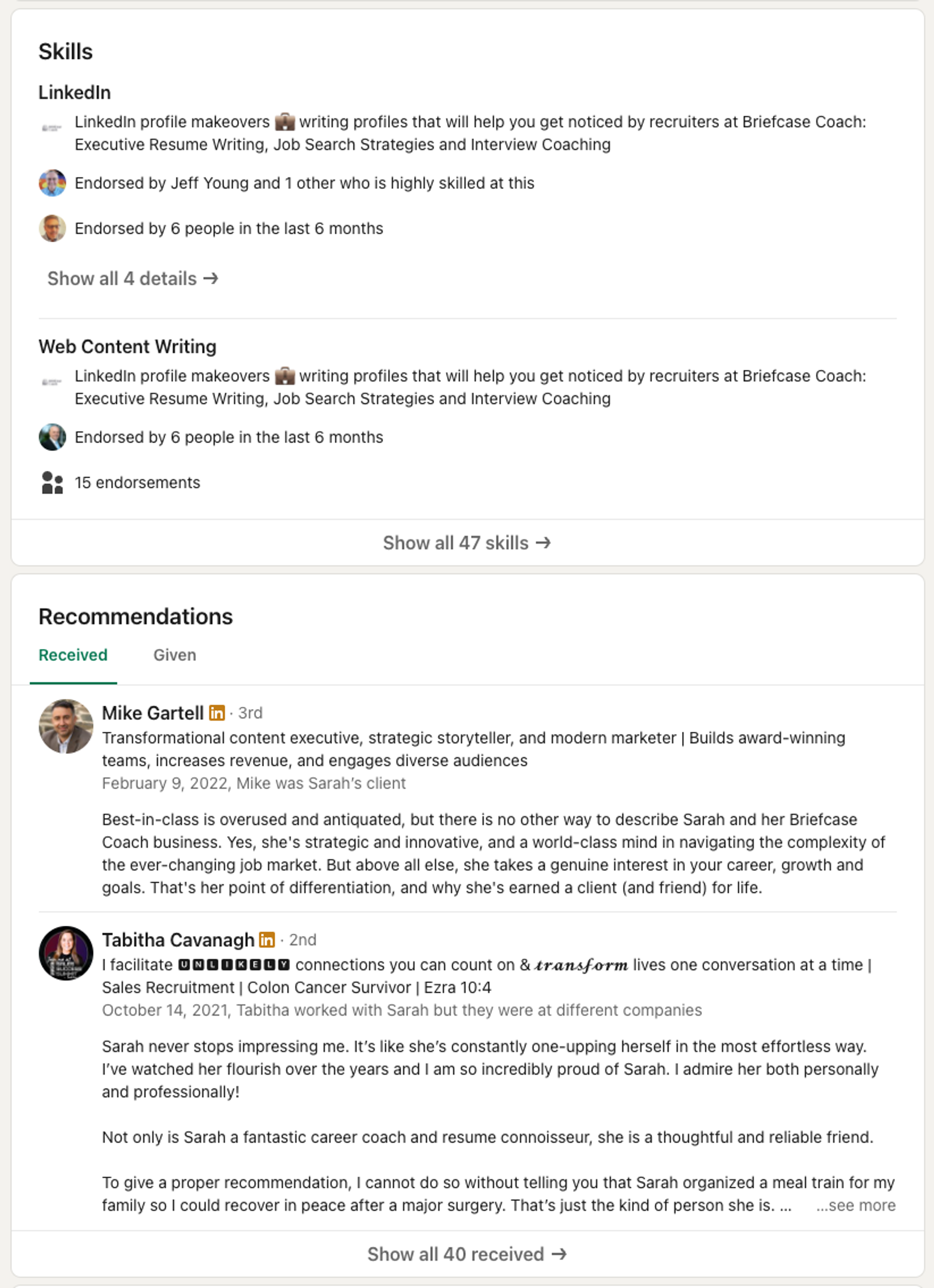
Image source: Sarah Johnston
2. Content Creation 📝
- Types of Content:
Why: Different types of content engage different segments of your audience.
How: Share industry articles, write thought leadership posts, and create short videos.
Pro Tip: Use multimedia like images and videos to make your posts more engaging.
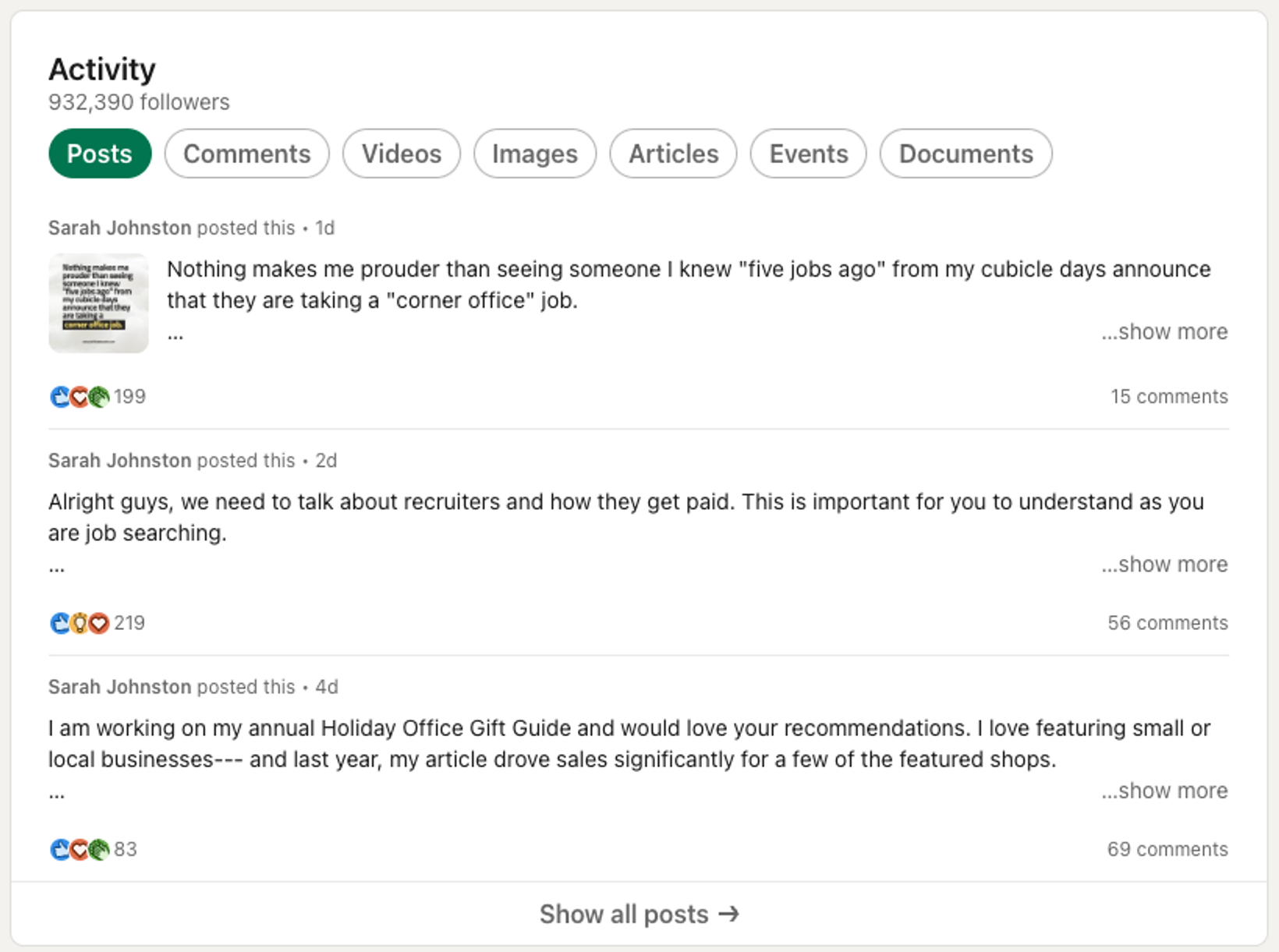
Image source: Sarah Johnston - Frequency:
Why: Consistency is key to staying top-of-mind.
How: Aim to post at least 3 times a week.
Pro Tip: Use scheduling tools to maintain a consistent posting schedule.

Free Notion Content Calendar Template from Joe Gannon - Engagement:
Why: Engagement increases the reach of your posts.
How: Always respond to comments on your posts. Ask questions to foster community.
Pro Tip: Tagging people in your posts can also increase engagement.
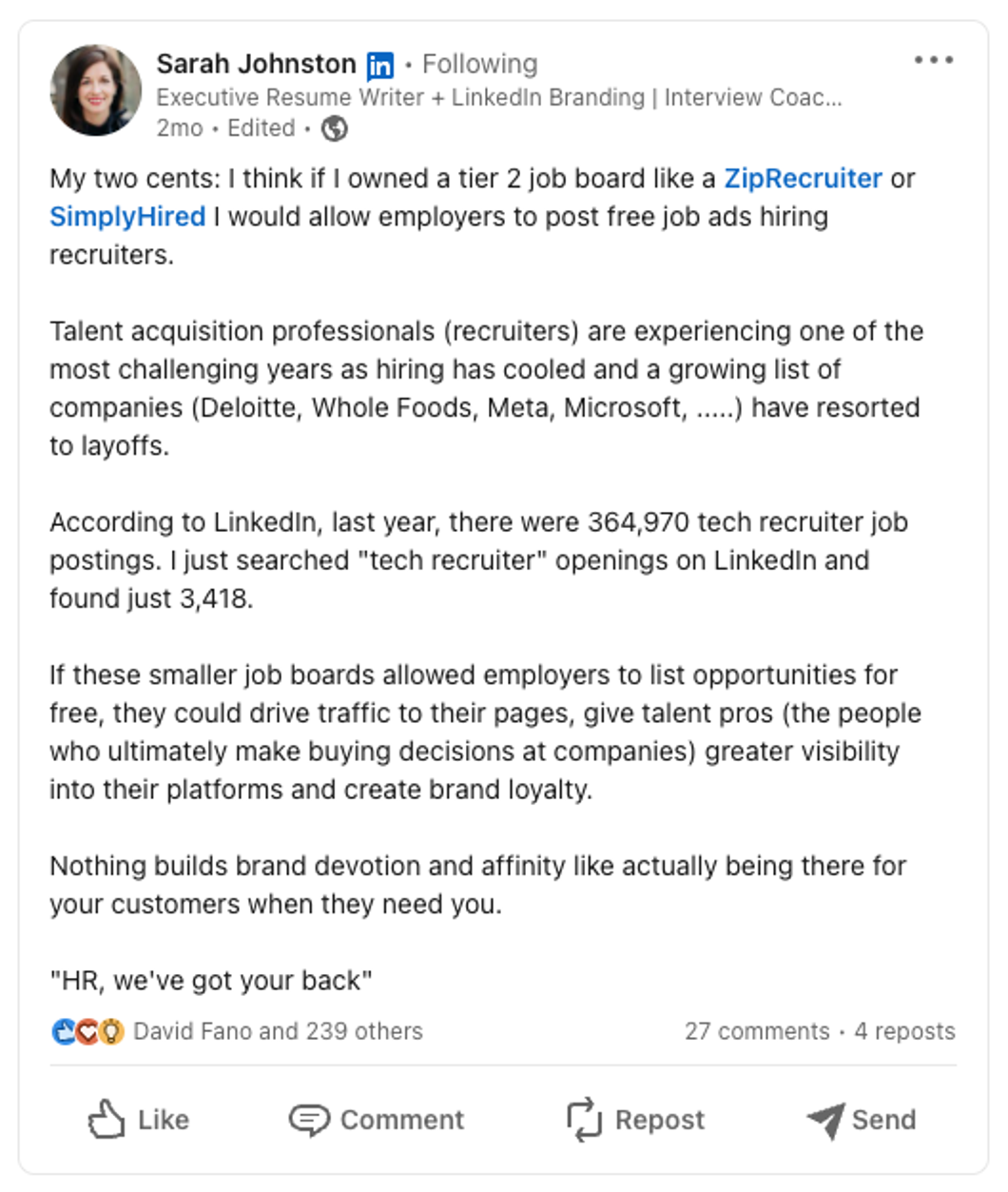
Image source: Sarah Johnston
✅ Use ContactOut’s AI Commenter via Chrome extension.
- Click on our ContactOut’s mascot ‘Connie’ icon to reveal 4 ways to generate a comment:
- 1. Add Value
- 2. Question
- 3. Compliment
- 4. Say thanks Remember to personalise and revise the generated comment to suit your tone of voice and personality, as well as share any other additional insights or tips.
Remember to personalise and revise the generated comment to suit your tone of voice and personality, as well as share any other additional insights or tips.
3. Engagement 🤝
- Daily Routine:
- Why: Daily engagement keeps you visible in your network’s feeds.
How: Spend 20-30 minutes each day liking, commenting, and sharing relevant posts.
Pro Tip: Use this time to also send connection requests and messages. - Networking:
Why: Quality connections are more valuable than quantity.
How: Don’t just hit ‘connect’; send a personalized message explaining why you wish to connect.
Example: “Hi [Name], I’ve been following your work in [Industry]. I’d love to connect and perhaps collaborate in the future.”

Image Source: Octopus CRM Blog
✅ Use ContactOut’s AI Connection Request Messaging feature to write personalized notes in seconds.
✅ Use ContactOut’s custom icebreakers via Chrome extension. Copy the one you like the most, tweak, or click “Refresh” until you land on the perfect message to engage with your audience.
4. Drive Traffic 📈
- Who’s Viewed Your Profile:
Why: These are people who have already shown interest in you.
How: Check daily and send a thank-you message.
Example: “Thanks for checking out my profile! How can I assist you today?”

Image Source: Octopus CRM Blog - Analytics:
Why: Understanding your audience behavior helps you tailor your strategy.
How: Use LinkedIn analytics to see which posts are getting the most engagement.
Pro Tip: Pay attention to metrics like ‘Post Views’ and ‘Profile Searches’.
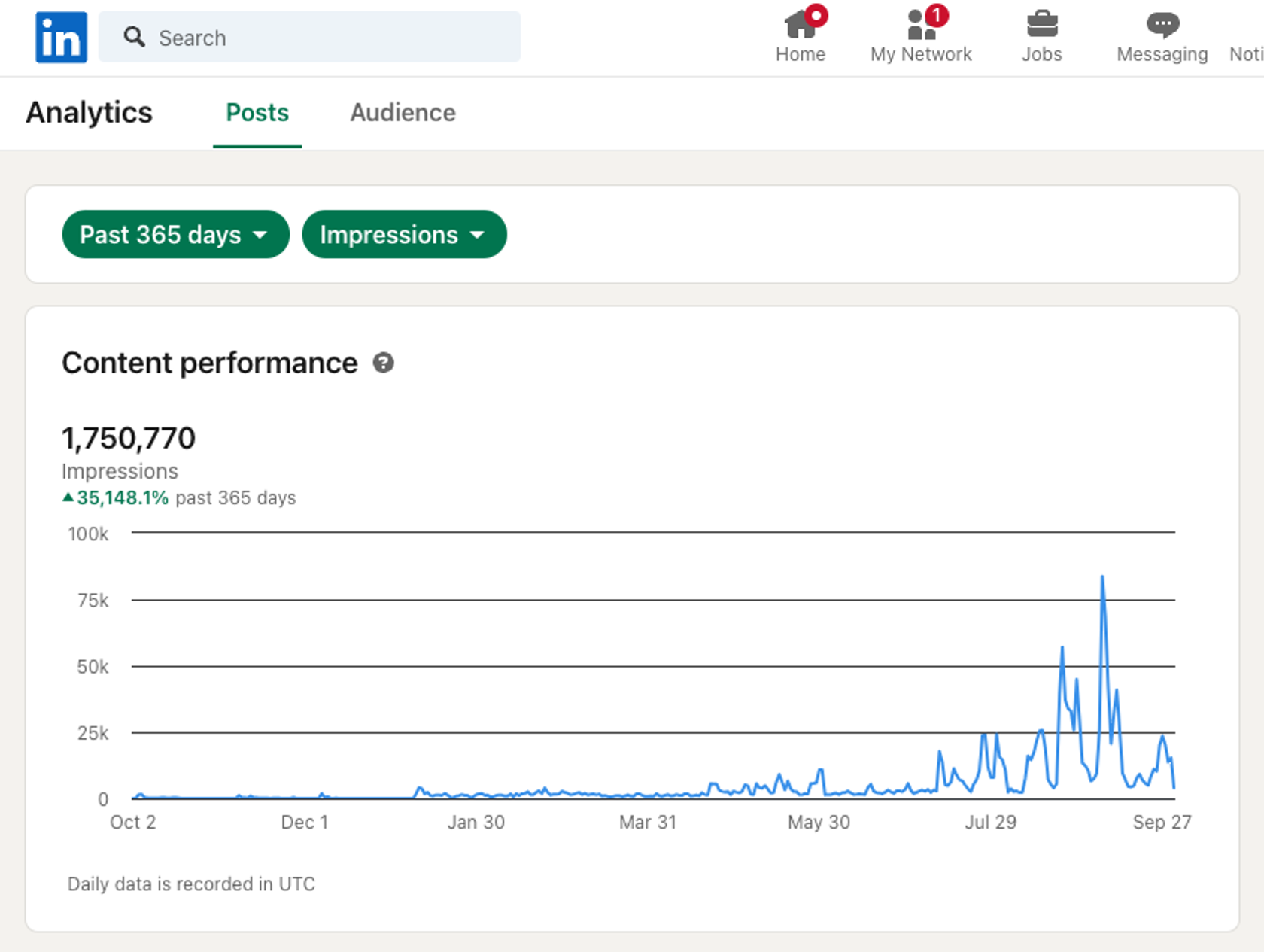
Here’s an example of it 🌍:
Setting the Stage 🎬
Imagine you’re a recruiter specializing in the tech industry, particularly in Artificial Intelligence (AI) and Machine Learning (ML). You understand that LinkedIn is a goldmine for connecting with top talent and innovative companies in these fields.
Your goal is to become the go-to recruiter for AI and ML roles.
Crafting the Perfect LinkedIn Headline 🖊️
- Headline: “Tech Recruiter Specializing in AI and Machine Learning | Connecting Talent with Innovation.”
Why: This headline immediately tells viewers your niche and value proposition.
How: Use industry-specific keywords like “AI” and “Machine Learning” to appear in relevant searches.
Content Strategy 📋
- Types of Content:
Articles: Share articles about the latest trends in AI and ML, such as breakthroughs in natural language processing or ethical considerations in AI.
Original Posts: Write posts discussing the challenges and opportunities in tech recruiting, perhaps focusing on diversity or remote work.
Videos: Create short video interviews with industry experts or offer quick tips on job searching in the tech field. - Frequency:
Why: Consistency keeps you on the radar.
How: Aim to post at least 3-4 times a week, mixing the types of content.
Engagement and Community Building 🗨️
- Comments: When someone comments on your post, don’t just ‘like’ it. Engage in a meaningful conversation.
Example: If someone comments, “Great insights on the AI job market!” you could reply, “Thank you! Are you currently looking for opportunities in AI, or are you more on the hiring side?” - Direct Messages (DMs): If the conversation in the comments becomes more in-depth, consider moving it to DMs for a more focused discussion.
Why: This can lead to more meaningful connections and potential job placements.
The Outcome 🎯
By following this example, you’re not just passively waiting for opportunities to come to you. You’re actively creating a brand that attracts them. When people in the AI and ML fields think about making a career move or hiring new talent, you’ll be the first person who comes to mind. This proactive approach significantly increases the chances of them viewing your profile and reaching out for job opportunities or partnerships.
Next steps🚶♂️:
1. Consistency: Keep Your LinkedIn Profile Updated 🔄
- Why: An outdated profile can give the impression of inactivity or lack of engagement, which can be a turn-off for potential candidates or clients.
- How:
Profile Details: Regularly review your headline, summary, and experience sections. Update them as you gain new skills or switch roles.
Profile Picture: Keep your profile picture current. A good rule of thumb is to update it every 1-2 years. - Pro Tip: Set a reminder on your calendar to review your LinkedIn profile every quarter. This ensures you never miss an opportunity due to outdated information.
2. Content Calendar: Plan Your Posts in Advance 📆
- Why: Planning your content in advance ensures you post consistently, which is crucial for keeping your audience engaged.
- How:
Brainstorm Topics: At the beginning of each month, brainstorm topics that are relevant to your industry and audience.
Create a Schedule: Use a content calendar to plan out when each post will go live. - Tools:
LinkedIn Native Post Scheduler: Allows you to schedule posts directly on LinkedIn.
Third-Party Tools: Platforms like Hootsuite or Buffer can also be used for scheduling and analytics. - Pro Tip: Always leave some room for spontaneous posts that are timely and relevant. For example, if there’s breaking news in your industry, you’ll want to comment on it right away.
3. Continuous Learning: Stay Updated with Industry Trends 📚
- Why: The recruiting industry is ever-changing. Staying updated ensures your content is fresh and adds value to your audience.
- How:
Follow Industry Leaders: Keep tabs on what thought leaders in your industry are saying.
Read Widely: Subscribe to industry newsletters, journals, and blogs.
Webinars and Conferences: Attend industry-specific webinars and conferences to gain new insights and network. - Pro Tip: Use what you learn to fuel your content creation. For example, if you attend a webinar on remote work trends, consider writing a LinkedIn post summarizing your key takeaways.
👋 By following these next steps, you’ll ensure that your LinkedIn profile and content strategy remain dynamic and relevant, solidifying your position as a go-to recruiter in your industry.
Further resources 📚:
- 📌 6 Steps to Building Your Recruiter Brand from LinkedIn Talent Solutions
- 📌 How to build a personal brand as a recruiter that generates more business
- 📌 Recruiter Relax: Tips to Build a Personal Brand That Works for You
- 📌 Hoxo’s LinkedIn Personal Branding Guide for Recruiters
- 📹 Personal Branding in Recruitment | Ask A Recruiter
- 📹 Personal branding series #1: Use personal content to build a rapport with your target audience
- 📹 Personal branding series #2 How can your marketing team support all areas of your rec business?
- 📹 Personal branding series #3: How does posting on LinkedIn actually turn into ROI for recruiters?
- 📹 Personal branding series #4: A LinkedIn formula that works for recruiters
- 📹 Sean Anderson on 5 weekly tips for any recruiter to build a personal brand on LinkedIn













